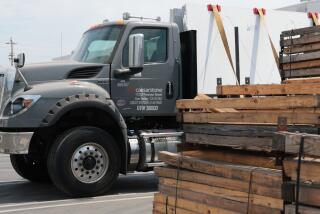Decades Later, Thousands Suffer âTime-Bombâ Aftereffects of Asbestos
IRONDEQUOIT, N.Y. â Dave Creighton didnât venture outside his air-conditioned home for six humid weeks last summer.
In the fall, no longer able to resist the lure of the outdoors, the stocky 56-year-old dressed up in blaze orange, borrowed a small tractor and trundled through the woods behind his hunting buddies. But he found himself gasping for air and soon quit from exhaustion.
Creighton thinks his lungs were irreparably damaged in the mid-1960s, during his early years as a mechanic stripping turbines at Rochester Gas & Electric Corp. He never felt any ill effects at the time. Thirty years sailed by before he noticed a shortness of breath.
The culprit is asbestos, the onetime miracle insulation fiber that now kills as many as 10,000 people a year in the United States.
Since his diagnosis in 1996 with asbestosis, a scarring of the lungs that leaves victims prey to cancer and heart failure, Creightonâs lung capacity has been steadily declining. It is now just 60% of what it should be.
Sitting at his kitchen table in this Rochester suburb with his wife, Nancy, he lists the good things he canât do anymore: fish, camp, tramp up and down hills, haul wood for a chain saw-artist friend, help neighbors with âbull work.â
âI donât do any of that anymore,â he said, lower lip quivering, eyes opening wide to hold back the tears. âItâs been something I would never wish on my worst enemy.â
In 1972 the federal government banned the use of asbestos in workplaces, chiefly shipyards, chemical and power plants, construction sites and other industrial locations where it had been valued for its insulation and fireproofing powers since the turn of the 20th century.
But 20 to 40 years can pass before the inhaled needlelike fibers manifest themselves in harmful ways--from relatively mild lung impairment to deadly cancers.
âThere is this sort of time-bomb effect,â said Dr. William Beckett, a University of Rochester professor of environmental medicine. âMany people who have worked with asbestos are very concerned about it and get frequent checkups.â
A 1982 study by Mount Sinai School of Medicine predicted 365,000 asbestos-related deaths by 2030, and those findings are largely holding up, said lead researcher Dr. William Nicholson, a professor emeritus of community medicine at the New York City school.
Some 27 million American workers were exposed to asbestos between 1940 and 1980, Nicholson found. Deaths from asbestos-linked cancers peaked at 9,000 to 10,000 a year through 2000 and will slowly fall but remain substantial for three more decades, he said.
âIt may very well go the way of polio,â said lawyer Dennis Herron, who helped Creighton obtain Social Security disability compensation, workerâs compensation and out-of-court payments from assorted companies that made, sold or distributed asbestos.
In this manufacturing region of nearly 1 million people on Lake Ontarioâs southern shore, lawyers handle âa solid 100 asbestos cases a year,â said Herronâs former partner, Joe Rinere. In the latest settlement in January, 17 retired Rochester Gas & Electric workers were paid $2 million. Three are already dead of cancer.
Above all other product-liability cases, asbestos lawsuits clog dockets in state and federal courts. About 200,000 claims are pending, and as many as 1 million have been filed so far, said Beth Caputo of Mealey Publications, which tracks litigation in the nationâs courts.
Asbestos makers have already forked out tens of billions of dollars in damages, and dozens of companies have been bankrupted. The erratic scale of payouts, however, is quickening a debate in Congress over how courts should handle the torrent of claims.
Tony Giancursio, 67, a plumber who apparently was exposed while training as a pipe fitter at Eastman Kodak Co.âs film manufacturing plant in the 1950s, had a lung removed soon after his diagnosis in 1996 with mesothelioma, a rare cancer of the chest and abdomen that killed him within nine months.
An athletic, 200-pound ex-Marine with eight children, Giancursio could no longer eat solids and became tormented by the smell of food. His stomach ballooned as he wasted away.
âHe was in such pain,â said his wife of 44 years, Grace. âEvery night, he was afraid to go to sleep. Heâd want each one of the kids to stay over. To see a big, healthy man like he was end up being an absolute skeleton, it was a horrible nightmare.â
Aside from worrying about lung cancer, Creighton fears his breathing will get shallower until he is tethered to an oxygen machine.
After a two-year stint as a Navy machinist, Creighton joined his hometown utility in 1964. Working on a turbine-repair crew, he often had to remove huge chunks of brittle asbestos insulation with a claw hammer.
âThere were days I can remember turning back and looking at that machine and it was one big cloud, nothing but asbestos,â he said. âWe wore no protective uniforms or masks.â
Many of his former colleagues died before reaching retirement. Creightonâs disability keeps him from the everyday tinkering around the house he once enjoyed so much.
âHe was a very physical person. He could open anything--I donât care how tight it was,â his wife said with a laugh, prompting Creighton to lift up his arm to display the flabbiness of his muscles.
Sometimes the reminders cut deeply. At a zoo a few years back, his toddler grandson âput his arms up for me to pick him up and carry him,â he recalled. âI couldnât carry him that far. You donât think that didnât hurt?â
One thing that keeps him going, he said, is the prospect of touring the country in their unused motor home once his wife retires with a pension in 2002 from her job as a high school math teacher.
âIâve still got things to keep me living,â Creighton said firmly. âItâs not the quality that Iâd like, but you go on.â
More to Read
Sign up for Essential California
The most important California stories and recommendations in your inbox every morning.
You may occasionally receive promotional content from the Los Angeles Times.










